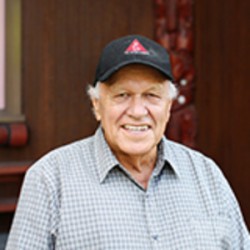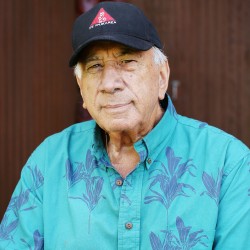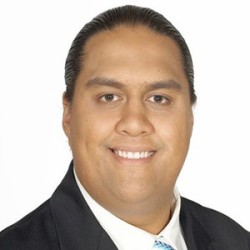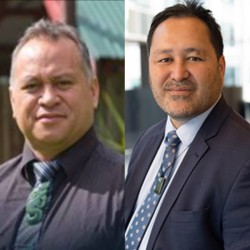Born Te Kumeroa Ngoingoi Ngawai on 29 December 1921 at Tokomaru Bay on the East Coast of the North Island, she was known affectionately as Ngoi. Ngoi was the eldest of five children of Hori Ngawai of Te Whanau-a-Ruataupare of Ngāti Porou of Tokomaru Bay, and his wife, Wikitoria Te Karu, of Ngāti Koi in the Hauraki region. Ngoi was raised in the Ringatu faith by her relatives Huka Pohaera and Raiha Kamau at Waiparapara. Her father, who worked as a labourer, was a minister of this church and an advocate of the Kotahitanga movement, which Ngoi herself later supported.
Ngoi attended Tokomaru Bay Native School. Her first language was Māori but she quickly acquired literacy in English and attended Hukarere Maori Girls’ School in Napier from 1938 to 1941. An able hockey player, after she left school she played for the Marotiri team at Tokomaru Bay and competed in tournaments around the North Island. These competitions combined sport with kapa haka. Ngoi was in her element in this context.
She returned to Tokomaru Bay after completing her education and worked in her aunt’s shearing gang. Through this work she met Rikirangi Ben Pewhairangi, a labourer, also of Tokomaru Bay. They were married by Ngoi’s father at Waiparapara marae on 3 February 1945. They had one son, Terewai Pēwhairangi, but raised many other children, including their own grandchild.
The couple continued to work in shearing gangs up and down the East Coast in their early married lives. In the sheds Ngoi was known for her mischievous nature and her singing. On one occasion, when her aunt, Tuini Ngawai, was competing in a competition, seeing her lagging behind Ngoi spontaneously burst into song to inspire her to pick up the pace.
She continued her interest in Maori performing arts as a member and leader of Te Hokowhitu-a-Tu Concert Party, which was founded by Tuini Ngawai in 1939. During the early 1940s they travelled around New Zealand entertaining and raising funds for the war effort. Ngoi was groomed by Tuini Ngawai in performance, composition and leadership, and she tutored and led the group on many occasions. Later, she compiled the book Tuini: her life and her songs (1985).
Considered an expert at adjudicating kapa haka competitions, she was frequently called upon to judge both in New Zealand and Australia and at festivals such as the Tamararo cultural competition, held annually in Gisborne, and the New Zealand Polynesian Festival (later the Aotearoa Maori Performing Arts Festival and now known as Te Matatini).
Ngoi Pēwhairangi herself composed many songs, such as ‘Kia kaha nga iwi’, ‘Ka noho au’ and ‘Whakarongo’. Many were written for specific events, including the visit of the prince and princess of Wales in 1983, when she was responsible for the organisation of the official welcome. She was renowned for her spontaneity in writing compositions for various people. Of these songs, ‘E ipo’, recorded by Prince Tui Teka, and ‘Poi e’, by Dalvanius Prime and the Patea Maori Club, are best known. They earned gold and platinum records for selling, respectively, 7,500 and 15,000 copies.
During the 1970s Ngoi was involved in many different projects with different oragnisations, this included acting as an adviser to the Department of Māori Affairs and also to the National Council of Adult Education. Ngoi was the co-founder (along with Katerina Mataira) of Te Ataarangi, a method of learning and teaching the Maori language. Te Ataarangi became so successful that its practitioners formed a national association at a hui convened by Ngoi in 1981. In 1983 she convened another hui which brought together skilled Maori and Pacific weavers for a week at Pakirikiri marae, Tokomaru Bay. They formed Aotearoa Moana Nui a Kiwa Weavers. She was also a foundation member of the Council for Maori and South Pacific Arts in 1979, alongside people such as Kuru-O-Te-Marama Waaka and Kingi Ihaka, serving until her death.
Ngoi Pewhairangi died on 29 January 1985, in her home at Tokomaru Bay, after a long illness, survived by her husband and son. She had been revered for her unrelenting work for the advancement of the Māori language and culture and the development of her ideal of a bicultural nation in which Pākeha would help to ensure the survival of the Māori language.
Tāmata Toiere would like to thank the Pēwhairangi Whānau Trust for their permission to share Ngoi Pēwhairangi's waiata on the site.





















